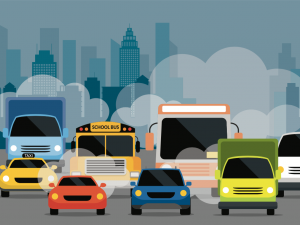From the DI sports desk, to international reporting on hunger and malnutrition
World-renowned journalist Roger Thurow started on The Daily Iowan’s sports desk. Now, he covers food shortages and malnutrition across the globe.
Roger Thurow sits at a hotel in Kenya.
November 12, 2018
University of Iowa alumnus Roger Thurow left Iowa City for a long and storied career with the Wall Street Journal; afterwards, the now 61-year-old journalist went on to pen three internationally renowned books on hunger.
Looking back on his career now, he is quick to point out that his love of writing began at The Daily Iowan — on the sports desk, of all places.
In fact, Thurow says the UI community has him to thank for the Hawkeyes’ last 27 winning seasons in football. And he might just be right.
A senior in the fall of 1978, Thurow sat at the City Editor’s desk, fresh off a stint of leading the DI’s sports coverage the year before.
“You won’t believe it, but the Hawkeyes didn’t used to be very good,” Thurow says now.
He remembers it was Halloween. The Iowa football head coach Bob Commings hadn’t achieved a single winning season despite performing notably better than Frank Lauterbur before him. That three-year coach led the Hawkeyes to the team’s first winless year the season before Commings replaced him.
So Thurow huddled with the DI editor-in-chief at the time — Bill Conroy — to put their complaints in an op-ed appropriately titled “Commings must go.”
“Commings was brought in to lead the team to a better neighborhood. But now Iowa football is headed for the junkyard again,” the pair wrote at the time.
In the next state Board of Regents meeting, Commings was ousted as Hawkeye coach.
The university’s next hiring was Hayden Fry — with the characteristic aviator-style sunglasses and bushy mustache that can be seen all over merchandise in Iowa Book, the Hawk Shop, and Raygun.
He turned the Hawks around, leading the team to its first winning season in 19 years in 1981 and winning three subsequent Big Ten Championships. Kirk Ferentz continued Fry’s winning career and just this season clinched the title of the Hawkeye football coach with the most victories, beating out Fry.
Former DI Publisher Bill Casey often joked about the column leading to the towering height of the Hawkeye football team now.
“Bill Casey will probably say the success of the Iowa Hawkeye football program and athletics is because of that,” Thurow joked.
The four-and-a-half-year Hawkeye also described the newsroom unionizing after the Vietnam War for the first time. Veterans who were staff photographers had families and gained insurance coverage and salaries before Thurow graduated in 1979.
But a long clip-list from the DI wasn’t the end of UI grad’s journalistic escapades. He ended up launching a career in 1980 at the Wall Street Journal after completing a senior-year internship there the summer following his legendary op-ed.
Soon after he secured the job, the newly employed Thurow met Scott Kilman, a DI reporter and future collaborator. Kilman remembered that the Houston/Dallas Bureau reporter returned to the UI for an awards dinner wearing a cowboy hat.
RELATED: On covering hunger in a hungry world
“It might even have had a feather in it,” Kilman said with a laugh. “I’m not sure. I knew he was from the Midwest, and my first thought was, ‘He went Texas really fast.’ ”
Kilman, who worked with Thurow at the Wall Street Journal, now describes him as a journalistic icon and a personal friend.
“He was legendary, even then,” said Kilman, a former reporter for the DI who later collaborated with Thurow on Pulitzer-nominated journalism work for the Journal.
“He’s just got a really good heart,” Kilman said. “People like him, they do the job they do because they believe if the public knows what’s going on, the public will care and react to try to make things better — he really lives that.”
Just a few years Thurow’s junior, Kilman reported on agriculture for the Journal, and Thurow reported internationally, hopscotching from country to country. As part of an effort by the paper to connect internationally, the two UI grads collaborated to track U.S. agriculture products to countries in which malnutrition and food shortages dominated the political climate.
The pair became 2004 Pulitzer Prize finalists in International Reporting for their collection of reporting on hunger internationally, called “The Anatomy of Famine.”
The collection was praised by the Pulitzer board for “haunting stories that shed new light on starvation in Africa and prompted international agencies to rethink their policies.”
Thurow, a stoic but easy-going journalist, went on to report on the fall of the Berlin Wall, Nelson Mandela’s release from prison, and the Ethiopian famine.
In fact, witnessing that famine drew him away from the daily deadlines of the Journal. He decided to leave the reporting desk in 2010 to pursue long-form journalism full time as a Senior Fellow for the Chicago Council on Global Affairs in the Global Food and Agriculture Program.
Armed with fresh memories of malnutrition in children, Thurow and Kilman set to work to write a collection of their most poignant stories, immortalized in ENOUGH, Why the World’s Poorest Starve in an Age of Plenty. The award-winning book eventually evolved into a trilogy, once Thurow decided to jump into long-form journalism.
RELATED: DITV: Raygun and National Hunger and Homelessness Awareness Week
“I like to call it the real hunger-games trilogy,” Thurow said.
Just two years after he broke off from the Journal, he wrote the second book in the series, The Last Hunger Season: A Year in an African Farm Community on the Brink of Change in 2012.
His latest book, The First 1,000 Days: A Crucial Time for Mothers and Children — And the World, details Thurow’s interviews with mothers with children under 1,000 days old.
The 2016 book examined malnutrition during children’s earliest years in countries in which infant-mortality rates are drastically high. Thurow described the ethical quandary of covering malnutrition as difficult.
“It was some of the hardest reporting I’d ever done,” he said. “Because you’d get into these situations where it is so easy as someone from the United States to say, ‘I can help that problem with whatever small amount of money’ — but I couldn’t.”
But, he said, he believed food shortages and hunger deserved his full attention and passion.
“In 2003, what I saw in Ethiopia reignited my passion for stories,” Thurow said. “I said, this is my purpose as a journalist, this is the story that I was meant to write about.”
And 15 years later, he says he’s not ready to stop anytime soon.





















